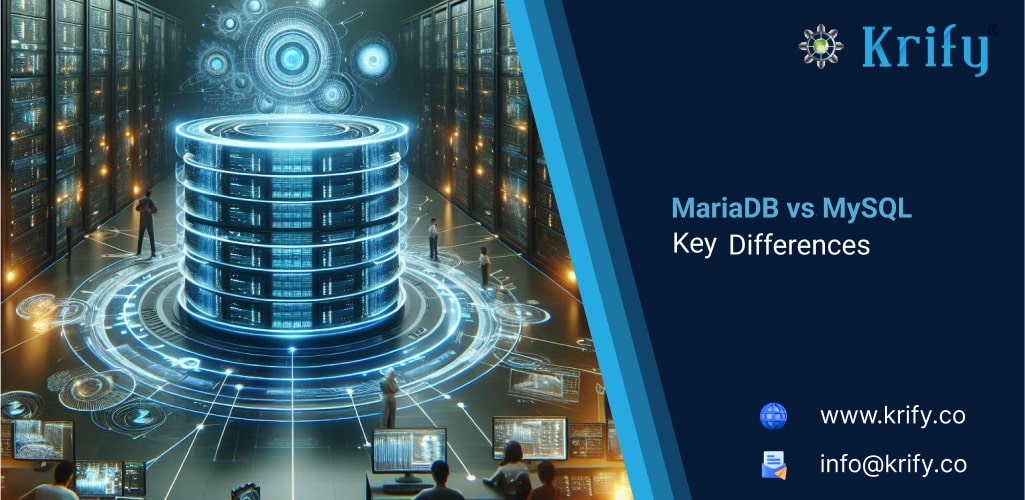Introduction
In the realm of relational database management systems (RDBMS), two names are frequently mentioned: MySQL and MariaDB. Both are open-source database solutions, but they have different histories, features, and use cases.
Understanding the fundamental distinctions between these two systems is critical for developers and database administrators when deciding which tool is best for their projects. In this blog post, we’ll look at the differences between MariaDB and MySQL, including their origins, performance, features, and compatibility
Origins and Development
MySQL
MySQL, initially released in 1995, has grown to become one of the most widely used relational database management systems (RDBMS). It was acquired by Sun Microsystems in 2008, and later by Oracle Corporation in 2010. MySQL’s development is now overseen by Oracle, which has raised concerns in the open-source community about its long-term commitment to keeping MySQL fully open-source.
MariaDB
MariaDB was built in 2009 as a fork of MySQL by its original developers, led by Michael “Monty” Widenius, following Oracle’s acquisition of Sun Microsystems. The major purpose was to keep a version of MySQL open-source and community-driven. MariaDB is maintained by the MariaDB Foundation, which values transparency and open development.
Licensing
One of the major distinctions between MariaDB and MySQL lies in their licensing.
MySQL
MySQL is available under the GNU General Public License (GPL), but Oracle also offers commercial licenses. This dual-licensing model allows for free use under GPL, but businesses that prefer or require a commercial license have that option.
MariaDB
MariaDB is released entirely under the GPL, ensuring that it remains free and open-source. There are no commercial licenses for MariaDB, which aligns with the MariaDB Foundation’s commitment to open-source principles.
Performance
Both MariaDB and MySQL are known for their speed and efficiency, but there are some notable differences in terms of performance:
- Query Optimization: MariaDB has implemented several enhancements to the query optimizer, resulting in better query execution plans and improved performance, especially for complex queries.
- Thread Pooling: MariaDB introduces thread pooling, which can significantly improve performance by reducing the overhead of creating and destroying threads for each new connection.
- Parallel Replication: MariaDB supports parallel replication, allowing for faster data replication across multiple slave servers, improving scalability and performance.
Compatibility
Compatibility between MariaDB and MySQL is an important factor to take into account. Applications and tools created for MySQL can typically be used with MariaDB without requiring major changes because MariaDB is intended to be binary-compatible with MySQL. Nevertheless, there are a few deviations and exceptions in the features, behavior, and syntax that can need alterations or testing.
Features
MariaDB often incorporates new features and improvements faster than MySQL. Here are some notable distinctions:
- Storage Engines: MariaDB includes several storage engines that are not available in MySQL, such as Aria, ColumnStore, and MyRocks. These engines provide enhanced performance, scalability, and storage options.
- Performance: MariaDB has introduced various performance enhancements, including better query optimization, thread pool improvements, and more efficient replication.
- JSON Functions: While MySQL and MariaDB both support JSON, MariaDB offers additional JSON functions and features that provide more flexibility in handling JSON data.
- Temporal Data Processing: MariaDB offers enhanced support for temporal data processing, including system-versioned tables, which allow you to keep a history of all changes to your data.
Community and Support:
MariaDB and MySQL both have thriving communities and support systems, although their strategies differ in a few key areas:
- MySQL: An active open-source community coexists with Oracle’s proprietary software, which also offers commercial support.
- MariaDB: As an open-source project, MariaDB is mostly dependent on its community for development, support, and contributions. On the other hand, businesses such as MariaDB Corporation also offer commercial support solutions.
Conclusion:
It’s critical to take your unique needs, priorities, and preferences into account while choosing between MariaDB vs MySQL. MariaDB might be a better option if you value improved performance, a community-driven approach, and cutting-edge features like parallel replication and greater support for JSON. But remaining with MySQL can be the most sensible choice if you need long-term commercial support or have other applications that are closely intertwined with MySQL. Contact us



